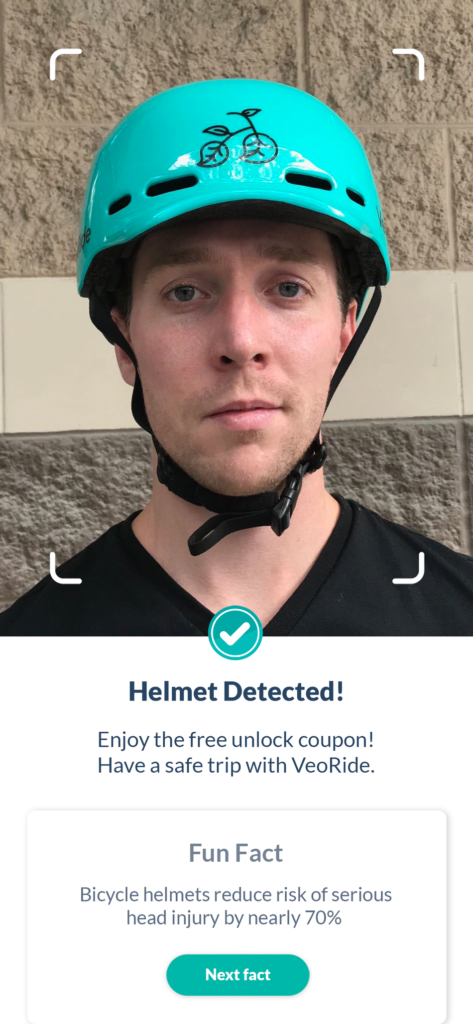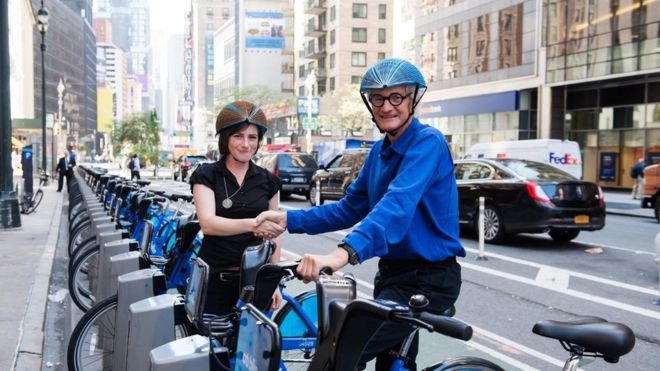Technology
Shared helmets
17 November, 2020
Safety improvement is one major focus for all the shared micromobility stakeholders. As local authorities are willing to ensure riders’ safety, operators are investing and looking for innovative features to check the “safety” box and win more new markets.
Improving helmet usage is one key development for shared e-scooter operators who are trying to find a good balance between extra costs on the hardware and operations, and getting the key differentiator. But how can they get there?
Incentives to wear a helmet
The cheapest and easiest-to-implement option to convince riders to wear a helmet is to provide educative content, either through the subscription or rental process, or push notifications. Most operators have already upgraded their apps this way.
The next step is to allow helmet detection. Before starting its ride, the user is taking a selfie, that is processed by an image recognition algorithm, to confirm if he is wearing a helmet or not. US operators Veo and Bird unveiled their solutions in September and November 2019 respectively. When riders confirm wearing a helmet, they can get free unlock or other rewards. I did not hear of any live implementation yet…

Credits : VeoRIde 
Credits : VeoRIde
Compact Helmets
The main barrier to helmet usage is… having a helmet. Would it be for occasional or regular riders, carrying a helmet all day long in case of a potential ride is highly constraining. The development of bike-share in the 2010’s led helmet suppliers to develop foldable helmets, with the ultimate goal of getting the more compact product. Closca (who launched a specific model in collaboration with Dott), Overade (which helmets are used by Tier) are among the most common. Other products, some made of paper such as the EcoHelmet, or the Testa model, might have more difficulties to be popularised due to their… singular design.

A recent product called Newton-Rider put foldable helmets back in the spotlight. The Danish company designed a thin, semi-soft, and foldable helmet using non-newtonian materials. It also has a built-in RFID chip that enables identification. Through a first-of-its-kind partnership with Voi, shared e-scooter riders now have access to rewards for wearing this helmet when scanning the chip before starting a ride.
Shared Helmets
The first versions of shared helmets appeared in states or countries where the mandatory helmet laws were a major barrier to the development of bike-share services. In Vancouver, Canada, for example, the operator had to offer systematic access to a helmet with the bike, and used a classic bowl helmet, secured thanks to Smoove’s cable lock (which is integrated into the handlebar). But, of course, there is no control of the presence of the helmet at the end of each ride.

Some scooter operators did not bother with the helmet volume and worked on its integration. Vancouver’s basic solution may have been an inspiration to Neuron who developed its own helmet securisation solution…Wheels unveiled its sitting-scooter with an integrated helmet in December 2019. Axel Lindner, GM for EMEA confirms that if “it has only been trialed in some cities [since then], we are launching at large scale (20% of the fleet) in Seattle today, Nov 16th, and we are continuing to work on scaling it to 100% of our fleet as soon as possible”. Wind Mobility unveiled a similar solution using a sliding tray to secure the helmet on its e-scooters’ direction tube, which equips the 100 e-scooters available in Bordeaux since September 2020.

Then you have the mix [foldable helmet + smart box] to make the helmet sharing solution more compact. Dott first officialised a partnership with the French start-up BumpAir – which is developing the first inflatable helmet on the market – to integrate their solution onto their scooters. The product is still in the development phase at the moment. Tier was the first to launch a finished product back in May 2020, with a smart box providing an Overade helmet. If the company is communicating a lot around this solution, it is still to be seen in Paris and Berlin where the launches were announced. Alexander Souter, GM for Western Europe, confirms the availability in Tampere (FIN), St. Gallen (SWI), Baerum (NOR), York (UK), and Oslo (NOR). In my opinion, it would first require a helmet easier to manipulate (check the video) to be largely adopted.
Challenges for shared helmets
In these times of pandemic, the main concern one would raise – that is also true for shared mobility services’ usage as a whole – is hygiene. It is extra work for the operators to sanitise the helmet and its box along with the vehicle itself – a new procedure now largely adopted. But the main difficulty is to ensure a perfect helmet hygiene condition, by providing disposable hygiene caps or wipes to clean the inside. It requires extra-space on the vehicle and regular control by the operation team to recharge it.
These extra costs do not only concern operations but also the hardware. Each vehicle would have to be retrofitted or equipped with the solution, then maintained during its life. Tier’s helmet retail price is 99€, plus the connected box price makes it a really expensive option. As 2020 made operators focusing on improving their unit economics, integrated helmets may not have been the first focus.
In the technical field, managing a helmet fleet requires monitoring it as the vehicle fleet. To ensure its presence at the beginning of each ride, helmets have to be paired to the vehicle, would it be through an RFID chip (remember Newton-Rider) or a QR code. It, therefore, requires additional development from the operators to adapt their software solution.
Once you know the helmet is always there, you have to ensure that it is in good condition for every ride. A reason why I am a bit skeptical about Wind’s solution, where the helmet can easily be damaged during a light crash or simply when a scooter is knocked over. An operator cannot give access to a damaged helmet without taking risks about its liability! In an ideal world, the helmet should have an automatic condition check feature easily understandable by the rider. As Bumpair‘s CEO Thomas Pandraud states: “Bumpair is the only one to provide it so far, as its inflating technology comes with a pressure indicator giving the green or red light to the user”.
All these challenges will require a long development process to get a finished product that matches all the shared micromobility needs. The current safety requirements from local authorities are nonetheless a huge incentive for operators to work on solutions in favour of helmet wearing.
Reason for NEVER using a helmet worn by anyone else:
Hygiene and the extremely high probability, not just the possibility, of contracting contagious diseases and parasites from a helmet that may have been worn by someone who has head lice, pubic crabs, typhus, SARS, and countless other serious diseases readily spread by fomites. The means and methods for 100% sanitizing and sterilizing helmets immediately after every use (not just periodically) would destroy the helmet. This isn’t about the Chinese Wuhan Virus which has extremely low fomite spread. It’s about countless OTHER deadly diseases.